Samsung ATIV Smart PC: Revisiting Clover Trail Convertibles
by Vivek Gowri on March 18, 2013 12:00 AM ESTSamsung ATIV Smart PC: Display
The ATIV Smart PC uses an 11.6” 1366x768 PLS capacitive multitouch display, with a Wacom digitizer. On paper, this is perfectly good, but there’s a problem here—like many of the older tablet PCs, there’s a grainy quality to the panel. When I say grainy, I’m referring to a slight sparkle or shimmer to the display, almost as though there are a number of specks in the panel. It’s not due to the active digitizer—Wacom’s EMR (electromagnetic resonance) system sits behind the display, as opposed to N-Trig digitizers which sit in front of the panel, so this is likely due to the Atmel capacitive touch digitizer.
The Smart PC Pro has a similar problem with screen grain (though to a lesser degree), but interestingly enough the Microsoft Surface Pro, which also has a Samsung-sourced PLS 1080p panel and an Atmel capacitive touch digitizer, has almost no digitizer grain. It’s really distracting, and I’m not sure why it isn’t mentioned more often. It’s actually really rare to see panels with digitizer grain now that the days of passive digitizers are over, and I seem to be seeing it more and more often with Samsung products (the Series 7 All-In-One is another one with noticeable grain). It’s a somewhat concerning trend, because it’s been a legitimately long time since this has been an issue on devices with capacitive touchscreens.
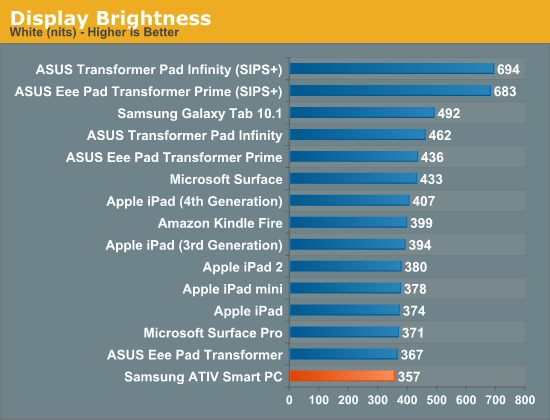
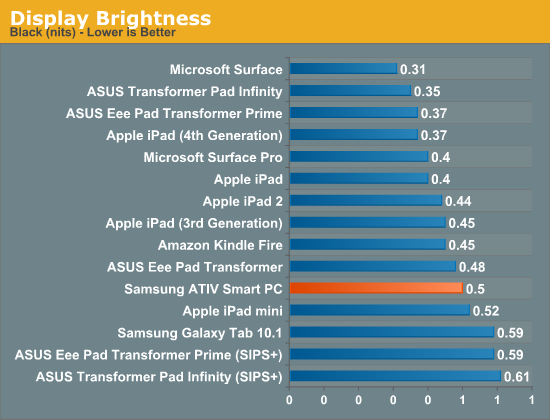
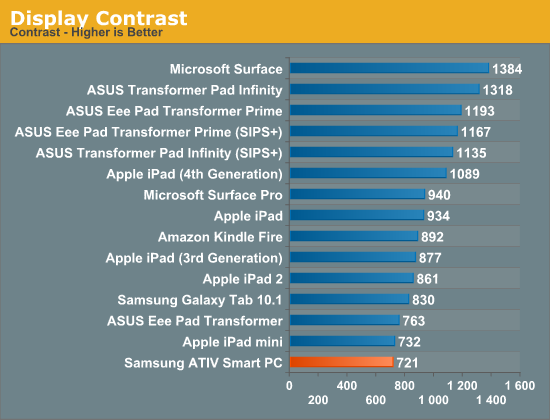
It’s a shame, because the performance is actually not bad—regardless of how the graphs look, the panel is pleasantly contrasty, with good color accuracy and a solid if not blinding maximum brightness. Every high end tablet these days has to come with a fantastic display, and even a tablet with a comparatively mediocre display like this one would still be one of the single best notebook/ultrabook panels out there. But yes, with a resolution of 1366x768 on an 11.6" panel, it does lag behind in terms of pixel density as well as performance compared to the cream of the crop of the tablet class.
Because this is Samsung, it’s a Super PLS (Plane-to-Line Switching) panel instead of IPS (In-Plane Switching). PLS was developed by Samsung and derived from IPS and supposedly offers a number of incremental improvements, including lower panel cost and higher brightness, but it’s quite hard to tell the difference between the two display technologies in day-to-day use. I do like that with the merging of small ultraportables and tablets, it’s getting much more common to find small and inexpensive mobile computers containing wide angle display technologies.
The Wacom digitizer is also a great feature to have, and I’m glad to see a resurgence in the number of Wacom-enabled devices hitting the market since the launch of Windows 8. Obviously, the most prominent of the lot is Surface Pro, but many of the other Intel-based tablets (ATIV Smart PC and Pro, VivoTab, ThinkPad Tablet 2, etc.) are coming with active pen support as well. I can’t remember the last time we had so many consumer focused active-digitizer tablets on the market, to be honest. For Samsung, this clearly ties in with their inking efforts with the Galaxy Note lineup on the Android side of things, and so we see digital inking applications like S-Note bundled in with the ATIV. And if you rely on OneNote for, say, notetaking in class, it’s a pretty wonderful inclusion.


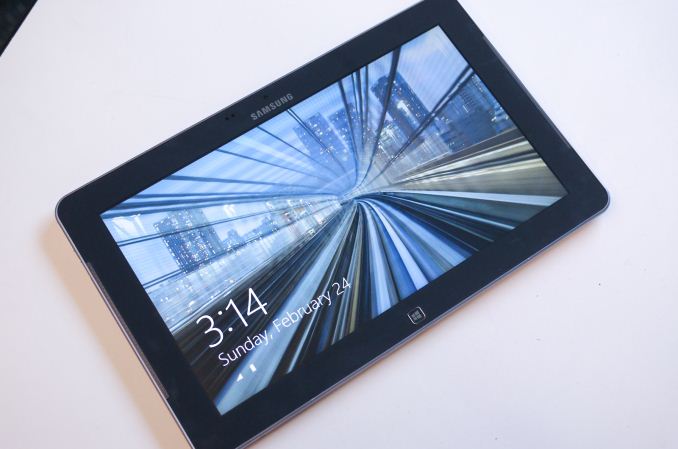
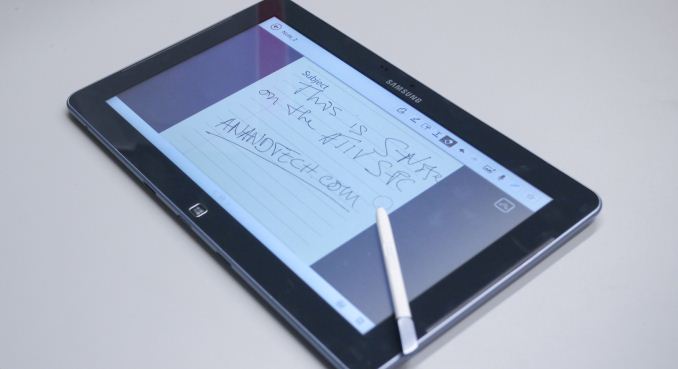








59 Comments
View All Comments
Krysto - Monday, March 18, 2013 - link
Why do Clover Trail devices need to be "revisited" every couple of months? Does Intel need Anandtech to do their PR for them?BrokenCrayons - Monday, March 18, 2013 - link
Though the internal hardware and performance expectations aren't going to change until there are improvements made to the silicon, the hardware package in which it resides that includes the case, screen, interface options, and battery along with other odds and ends make devices themselves worth a look. Samsung, in this case, is different with respect to build quality that is something of a shortcoming.That aside, Clover Trail is pretty uninteresting as a platform outside of putting it in the perspective of battery life. Priced at over $700, I don't personally see the appeal of what is, in essence, a netbook that costs over double the price when compared to budget-friendly systems of only a few years ago. There's just not enough benefit to offset the cost increase over a bargin bin AMD C-60 or last-gen Atom netbook for which I can simply carry an additional battery. if I want endurance as I'd be the sort to leave the keyboard dock forever attached and rarely bother to touch the screen.
Pirks - Monday, March 18, 2013 - link
Why are you lying about Clover Trail tablet prices being over $700 when in fact they start at $479?See this as a proof: http://www.newegg.com/Product/Product.aspx?Item=N8... and this too: http://www.newegg.com/Product/Product.aspx?Item=N8...
Are you a Google and/or Apple fanatic by any chance? Just curious ;)
BrokenCrayons - Tuesday, March 19, 2013 - link
From the first page of the article:"Clover Trail meant good battery life and x86 compatibility, the inclusion of Wacom active digitizers were exciting, and the 11.6” PLS/S-IPS displays seemed promising. The two are very comparable devices, though the ASUS is priced higher at $799, and doesn’t include the laptop dock anymore (it did at launch.) That gives the Samsung a pretty sizable price advantage, as $749 is only about $50 more than the 64GB Windows RT tablets when the keyboard accessory cost is included—more than worth it given the disparity in features and capability."
Death666Angel - Tuesday, March 19, 2013 - link
You realize that you are talking about all Clover Trail tablets, while Vivek just talks about 2 very specific, premium products? If you don't need a keyboard dock and an active digitizer, you can get Clover Trail tablets much cheaper. And in turn, if you need a keyboard dock and especially an active digitizer, comparing that price with old netbooks is useless, as they are useless for that specific need.BrokenCrayons - Tuesday, March 19, 2013 - link
The scope of my original post and response do not encompass, as you imply, "all Clover Trail tablets" outside of considerations of overall platform performance. The majority of the discourse concerns the Samsung tablet in specific and its various shortcomings relative to the MSRP under consideration of the benefits offered in exchange for the costs.With regards to my needs for a various features such as an active digitizer, I've already mentioned that previously. "I'd be the sort to leave the keyboard dock forever attached and rarely bother to touch the screen." In light of my own usage model and requirements, the price of the Samsung isn't justified or reasonable when one can acquire similar performance from low cost hardware available at office supply stores.
http://www.officedepot.com/a/products/592409/Acer-...
Understandably, your personal preferences and desires for a computing platform might be different. That's perfectly reasonable, but the mold which suits your needs may not be universally applied to others.
Death666Angel - Tuesday, March 19, 2013 - link
Then you should amend that sentence:"That aside, Clover Trail is pretty uninteresting as a platform outside of putting it in the perspective of battery life. Priced at over $700, I don't personally see the appeal of what is, in essence, a netbook that costs over double the price when compared to budget-friendly systems of only a few years ago."
As you make no effort to distinguish between different CT platforms. And when you get called out for it, you quote the article which just mentions 2 examples.
duploxxx - Monday, March 18, 2013 - link
typical OEM behavior, go with the flow i.s.o. design to differentiate. There has always been a netbook atom killer called Brazos, same for the tablet space it exists, http://www.anandtech.com/show/6672/vizio-tablet-pc... no slugish gui or impossible 3d like on the clovers, i had many tabs in house for testing, just makes the all day experience horrible. from an smooth workable gui experience (swiping between screens, switching applications) on tablets: IOS > ANDROID = AMD Soc >>>>> Clover this is how you can rate the experience.nerd1 - Monday, March 18, 2013 - link
I don't care about UI experience, I do care about the active digitizer (for inking) and battery life.DanNeely - Monday, March 18, 2013 - link
The part of the Asus device chaos that's annoying me the most is that from what I can tell from their webpage; their 10" atom model is only available with a wireless keyboard and a cover that can be folded up to let the two imitate a laptop on a table while the winRT model has an actual keyboard dock with the extended battery and ability to use like a laptop even if a perfectly flat surface isn't available. The atom tablet and keydock would otherwise match what I am looking for almost perfectly.